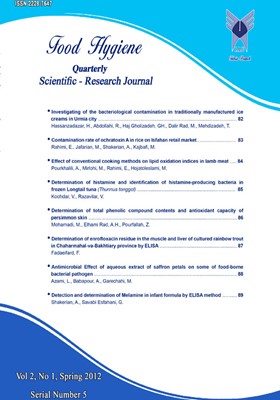Prevalence and antibiotic resistant of Campylobacter spp. isolated from different stages of sheep slaughterhouse
Subject Areas : Food Science and Technology
امیر Shakerian
1
*
![]() ,
ابراهیم Rahimi
2
,
سیامک Kazemi
3
,
ابراهیم Rahimi
2
,
سیامک Kazemi
3
1 - Department of Food Hygiene, Faculty of Veterinary Medicine, Shahre Kord Branch, Islamic Azad University, Shahre Kord, Iran.
2 - Department of Food Hygiene, Faculty of Veterinary Medicine, Shahre Kord Branch, Islamic Azad University, Shahre Kord, Iran.
3 - Graduated of Veterinary Medicine, Faculty of Veterinary Medicine, Shahre Kord Branch, Islamic Azad University, Shahre Kord, Iran.
Keywords: lamb, Antibiotic resistance, slaughterhouse, Campylobacter,
Abstract :
Campylobacter jejuni/coli are frequent causes of diarrhea in humans worldwide originating in foods of animal origin mainly from meat. The aim of this study was to determine the prevalence of Campylobacter spp. in lamb at different stages of the slaughter line including: after-skinning, after evisceration and the end of slaughter process. A total of 150 lamb samples (50 samples per each stage) were collected over a period of 16-month between January 2006 and May 2008, and were analyzed for the presence of Campylobacter spp. According to the results, Campylobacter spp. were isolated from 11.3% (17/150) of the carcasses from the three sampling stages. Among the isolates, 76.5% were identified as C. jejuni and 23.1% as C. coli. Campylobacter spp. were isolated from 5%, 8% and 4% of carcasses during the stages of after-skinning, after-evisceration and the end of slaughter process, respectively. Antibiotics susceptibility of 17 isolates were determined for ten different antibiotics using the disk diffusion assay. Results revealed that 58/8% of the isolates were resistant to ciprofloxacin, while 47/1% of the isolates to nalidixic acid, 41/2% to tetracycline, 29/4% to enrofloxacin, 23/5% to ampicillin, 5/9% to amoxicillin, and 5/9% top streptomycine. None of the isolates was resistant to erythromycin, chloramphenicol and gentamicine. This study emphasizes the application of a preventive system such as HACCP (Hazard Analysis of Critical Control Points) for the control of Campylobacter contamination in slaughterhouse.

